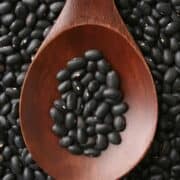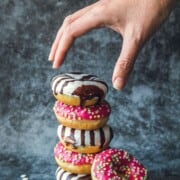You may hear histamine and instantly think about allergies, and you wouldn’t be wrong. Histamine is a compound that is involved in allergic reactions and the body’s inflammatory response. But, histamine intolerance is not the same thing as allergies. Since it can cause a host of symptoms and issues in the body, I’m going to give you an overview that explains what it is, and how you can begin to address it.

QUICK REFERENCE
Histamine is Your Friend
To understand what histamine intolerance is let’s first understand what histamine is. The National Institute of Health likes to refer to histamine as a ‘frenemy’ of the body. And that’s because it’s a little bit of friend and foe.
Histamine is a compound in our body that’s essential to our immune and digestive systems, and plays a key role as a neurotransmitter in our central nervous system, communicating important messages from the body to the brain.
Truth be told, it’s a complex compound. Not only does it have an effect on the inflammatory process of the immune system, but it also has regulatory functions in both the innate and adaptive immune responses. (1)
The inflammatory response happens when the body detects an antigen, and immune cells (also known as B cells) make IgE antibodies. These IgE antibodies then spread throughout the body instructing the immune system to be on the lookout for specific pathogens. Mast cells and basophils pick up the IgE antibodies and become sensitized to them. When they then come into contact with targeted antigens, they release histamine and other inflammatory chemicals, which cause blood vessels to become thinner. Now the body’s white blood cells can cross these barriers more easily, and join in the immune response, fighting and eliminating pathogens from the body.
Histamine has pleiotropic actions due to the different natures of its receptors, which means that it also helps to promote homeostasis in the body and is involved in immunomodulation, the process that down-regulates the immune system’s inflammatory response so that the body does not continue to attack itself once a threat is gone. (1)
In addition to the role histamine plays in the immune system, it also signals when the stomach cells should produce more stomach acid to promote healthy digestion and helps to keep our brains awake and alert. Anyone who has felt the grogginess caused by antihistamines can certainly attest to that!
Histamine is Your Foe
Despite all the good that histamines do in the body, it also has a bit of a dark side. Histamines are at the root of all allergies: hay fever, food allergies, and skin allergies. And, allergies affect so many of us, young and old. Since histamine is a signaling molecule, it doesn’t always get things right, and in the case of allergies, the immune system overreacts in response to harmless substances, mistaking them for antigens. Whether it’s pet dander, pollen, or food, the histamine response happens and comes with a whole host of unwanted symptoms.
Allergy sufferers will recognize this list of symptoms all too well:
● Watery eyes
● Runny nose
● Itching and hives
● Diarrhea or vomiting
● Anaphylaxis
To recap, in a balanced and properly reacting body, histamine should be released in response to something in the body, and then it should be broken down by enzymes and removed from the body. Allergic reactions are an inappropriate histamine response, but, unfortunately, they’re not the only negative that’s associated with histamine.
Histamine Intolerance
Histamine intolerance, also known as sensitivity to dietary histamine, is a disorder that results from the body’s inability to metabolize histamine that has been ingested. In order to clearly differentiate food allergies from sensitivities and intolerances, adverse reactions to food that do not have an immunological basis are referred to as non-allergic food hypersensitivity. (2) Basically, it’s as if the body is having an allergic reaction when there is no allergen present.
When the intestine has a reduced ability to break down histamine in the body, most likely due to a deficiency in a histamine-degrading enzyme, like diamine oxidase, or DAO, then histamine accumulates in the body, leading to an imbalance that causes symptoms of histamine over-reactivity.
Clinical manifestations of histamine intolerance are varied and nonspecific, which makes it difficult to determine if you are dealing with this intolerance. Because the four histamine receptors in the body are dispersed in different organs and various bodily tissues, symptoms of histamine intolerance can be widespread.
Symptoms may include:
- Gastrointestinal discomforts, like bloating, feeling of fullness, diarrhea, constipation, and abdominal pain
- Symptoms of the nervous and cardiovascular systems, like anxiety, dizziness, low blood pressure, heart palpitations, headaches, and migraines
- Respiratory symptoms, like runny nose, sneezing, shortness of breath, and chronic rhinitis
- Dermatological symptoms, like itching, flushing, eczema, hives, and rash
In a study that was trying to assess the clinical picture of histamine intolerance, 97% of cases experienced combinations of three or more symptoms involving different organs and they had an average of 11 symptoms per patient. (3) This makes it difficult to create appropriate diagnostic criteria for histamine intolerance. Histamine can even mimic hormone imbalance causing hot flashes.
Root Causes of Histamine Intolerance
At the root of histamine intolerance is an inability or reduced ability to break down ingested histamine. This can result from genetic or acquired impairment of the enzymatic function of DAO or other enzymes responsible for metabolizing histamine. (4) Some other possible factors that may contribute to it include:
- Poor gut health or gut damage
- Stress
- Thyroid or sex hormone imbalance
- Nutrient deficiencies
- Poor methylation in the liver
And, like many other problems in the body, it is often a combination of factors that leads to histamine intolerance.
Plan of Action
If you know or suspect that you may be dealing with an issue of histamine intolerance, you should first begin by changing your diet. Reducing your intake of high-histamine foods can help your body once again find balance.
High histamine foods include:
- Fermented foods that are not fermented in an airlock system
- Red Wine
- Vinegar
- Citrus Fruits
- Avocado
- Tomatoes
- Strawberries
- Coconut
- Fish
- Pork
- Foods that are aged or cooked for a long time, like meats and cheeses
- Leftovers - the histamine levels of stored, cooked foods increase as they sit
After removing offending foods from your diet, you should then investigate the underlying cause of your histamine intolerance. Addressing high-histamine foods, working to identify any underlying issues, and moving towards a more balanced body can help you begin to heal slowly and reduce any negative symptoms you’re experiencing.
Struggling with autoimmunity or chronic illness? Check out these success stories from clients who addressed the root-cause contributors of their autoimmune disease and are now thriving!
Sources
- Castelo Branco ACC, Seiti F, Yamada Yoshikawa SF, Pietrobon AJ, Sato MN. "Role of Histamine in Modulating the Immune Response and Inflammation", Mediators of Inflammation, 2018;(10):2018.
- Comas-Basté O, Sánchez-Pérez S, Veciana-Nogués MT, Latorre-Moratalla M, Vidal-Carou MDC. Histamine Intolerance: The Current State of the Art. Biomolecules. 2020;10(8):1181.
- Kovacova-Hanuskova E, Buday T, Gavliakova S, Plevkova J. Histamine, histamine intoxication and intolerance. Allergologia et Immunopathologia, 2015;43(5):498-506.
- Maintz L, Novak N. Histamine and histamine intolerance, The Amer Jour of Clin Nut, 2007;85(5):1185-1196.
















Comments
No Comments